|
|
|
Sort Order |
|
|
|
Items / Page
|
|
|
|
|
|
|
| Srl | Item |
| 1 |
ID:
170540
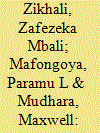

|
|
|
|
|
| Summary/Abstract |
This study assessed the provision of informal training offered by the Limpopo Department of Agriculture, South Africa, to agricultural extension officers (AEOs). The study used surveyed 90 public extension officers purposively sampled. There were statistically significant differences in extension officers’ exposure to climate change between their education levels and in the provision of climate change training between extension officers’ work experience (P⩽0.05). The study concluded that the majority of AEOs have not been fully exposed to climate information prior to their employment. This suggests that the information gap in Agricultural Extension and Advisory Services (AEAS) stems from the slow mainstreaming and integration of climate change information.
|
|
|
|
|
|
|
|
|
|
|
|
|
|
|
|
| 2 |
ID:
170539
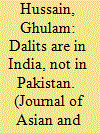

|
|
|
|
|
| Summary/Abstract |
This paper is an attempt to investigate the discursive bases of the categorical and identity-based choices available to the Dalits under the Ashrafia hegemony, and the resultant denial of Dalitness prevalent among the Dalits and the Sindhi civil society in, Pakistan. Informed by the Ambedkarian (subaltern) perspective, I analyse the conversational interviews conducted with the Dalit activists (mostly Scheduled Castes), and with their Ashrafia class counterparts. Interrogating the superior status of Sayed caste(s), I contend that the the denial of casteism, the opposition to the use of the ‘Dalit’ identity marker and the negation of the Dalitness seemed to have as much to do with the belief in Ashrafia values as it had with the normative sanction of the Savarna. values.Both the Savarna and the Ashrafia values seemed to seek legitimacy from the dominant ethnocentric forms of the politicized Sufism. Political Sufism merges the Savarna and Ashrafia norms by means of the syncretic narrative based on interfaith harmony and the civilisational rhetoric. Ashrafisation (also Savarnisation) and the reverence towards Sayeds were the key self-perpetuating hegemonic processes underlying the attempts by the Dalits and the civil society activists to dissipate cognitive dissonance underlying the existing Dalitness and the Ashrafia hegemony. I, therefore, conclude that the practices and the narratives prevalent in Sindhi civil society undermined the Dalit agency to come up with their own counter-hegemonic and emancipatory narrative(s).
|
|
|
|
|
|
|
|
|
|
|
|
|
|
|
|
| 3 |
ID:
170538
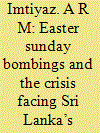

|
|
|
|
|
| Summary/Abstract |
This paper primarily examines the Easter Sunday bombing plotted and executed by a group of Sri Lankan Muslims and post-war Sri Lankan conditions among Sri Lankan Muslims, also known as Moors. The article will attempt to argue that (a) the post-war violence and organized Islamophobia among non-Muslim communities in general and the Sinhalese in particular increased fears and distrust among Sri Lankan Muslims in general; and (b) state concessions to Muslim political leaders, who supported successive Sri Lankan ruling classes from independence through the defeat of the Liberation Tigers of Tamil Eelam (LTTE) in 2009, have meant an isolation of the community from the other two main ethnic communities. The concessions that the Muslim community has won actively helped the Muslim community to be proactive in its religious practices and thus paved the way for exclusive social and political choices. The rise of Islamic movements and mosques in the post-1977 period galvanized Muslims. In time this isolation has been reinforced by socio-religious revival among Muslims whose ethnic identity has been constructed along the lines of the Islamic faith by Muslim elites. Despite this revival it has been clear that the Muslim community has been reluctant to use Islamic traditions and principles for peace building, which could have helped to ease tensions, brought about by the 30-year-old ethnic conflict. Finally, some pragmatic ways to ease tensions between Muslims and non-Muslims in the greater discipline of conflict resolution are explored using traditions within Islam.
|
|
|
|
|
|
|
|
|
|
|
|
|
|
|
|
| 4 |
ID:
170543
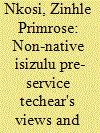

|
|
|
|
|
| Summary/Abstract |
This paper explores non-mother tongue isiZulu pre-service teachers’ views and experiences on learning isiZulu as a second language. The study uses qualitative study methods and it operates under the interpretivist paradigm. Semi-structured interviews are used with 20 students. Among findings are issues that relate to the usefulness of learning isiZulu as a compulsory module, good student attitude and academic performance. One of the recommendations is that there is a need to separate students studying isiZulu for the first time and those who are not studying it for the first time.
|
|
|
|
|
|
|
|
|
|
|
|
|
|
|
|
| 5 |
ID:
170542
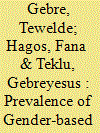

|
|
|
|
|
| Summary/Abstract |
In Ethiopia, large numbers of women are at higher risk of gender-based violence and harmful traditional practices. The main aim of the study is to explore the prevalence rate of gender-based violence and harmful traditional practices against women in the Tigray region, Ethiopia. In this study, a total of 1253 women were surveyed, of which 560 were from rural areas. Further, 14 focus group discussions and in-depth key informant interviews were conducted with relevant governmental and non-governmental bodies. It was found that a significant number of married women were not asked for their permission to be married and their mate was mostly selected by their family. Among others, age was found to be a statistically significant predictor for early marriage and permission of girls to get married with an odds ratio of 0.95 and 0.97, respectively (p < 0.05). Twenty-one forms of gender-based violence and 29 forms of harmful traditional practices and stereotypes against women were identified. These practices were mostly supported by the community. While gender-based violence was found to be somewhat higher in urban areas, most of the harmful traditional practices were slightly higher in rural areas.
|
|
|
|
|
|
|
|
|
|
|
|
|
|
|
|
|
|
|
|
|